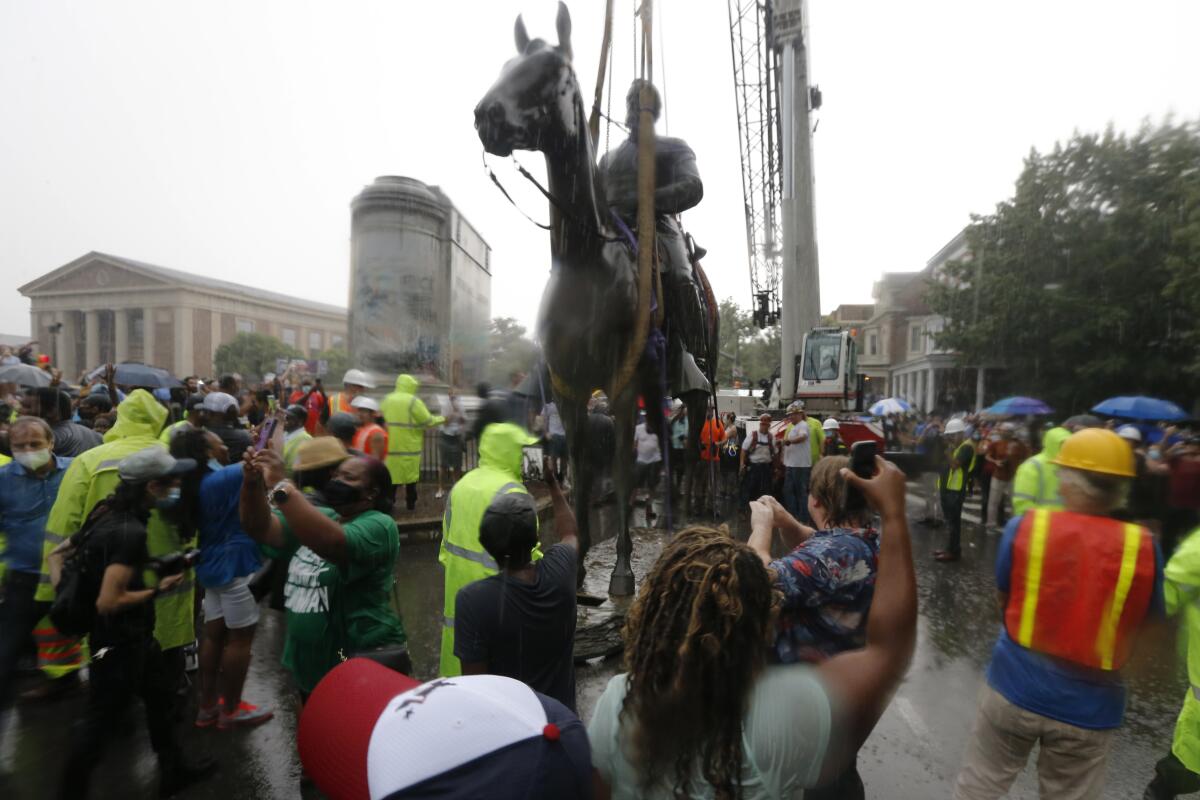To judge monuments, think about their meaning

- Share via
WASHINGTON — At Gettysburg, where the bloodiest and most decisive battle of the Civil War occurred, no fewer than 1,320 monuments are scattered across the rolling Pennsylvania landscape. Some memorialize Union generals and their men; others remember Confederates.
One is especially poignant: the Maryland monument, which lists both Union and Confederate units from one divided state. It depicts two wounded men, one from each army, propping each other up.
There’s a statue of Confederate Gen. Robert E. Lee, surveying the battlefield on horseback, and another of the Union commander, Gen. George G. Meade.
The Union monuments outnumber those of the Confederates, just as their armies did in 1863.
It’s an open-air museum, and it leaves no doubt which side won: the North.
Hospitals in Texas and Arizona are straining, and caseloads are soaring nationwide, but Trump continues to downplay the coronavirus and advocate reopening.
Almost 200 miles to the south, in Richmond, Va., Civil War statues were erected to convey a very different message.
Monument Avenue is the Virginia capital’s grandest boulevard. Until recently, it was dominated by heroic statues of Lee, Stonewall Jackson, Confederate President Jefferson Davis and others.
They are the men who lost the war — but on Monument Avenue, they appeared triumphant.
That was the point. Richmond’s statues were erected more than a generation after the war ended, after white segregationists regained control of the Southern states.
“The message [was] a victory narrative about the overturning of Reconstruction and the reestablishment of white supremacy,” Yale historian David W. Blight, the biographer of Frederick Douglass, wrote last week.
Now the Richmond statues are coming down. Protesters toppled Davis on June 10, the city removed Jackson, and the governor is battling in court to remove Lee.
Their removal is long overdue. By contrast, Lee’s statue in Gettysburg should remain standing because its meaning is so different.
In Richmond, Lee appears dominant, his presence designed to intimidate. At Gettysburg, outnumbered by federal troops and about to lose the most important battle of his career, he appears in a more appropriate context — as history, not mythology.
The distinction is not only whom the statue shows, but what message it conveys.
Monuments to George Washington and Thomas Jefferson celebrate their wisdom in founding the republic, not their flaws, chief among them their ownership of slaves. We honor them despite those flaws, not because of them.
Statues of Christopher Columbus pose a tougher question. Are we honoring him for his intrepid navigating or because he opened the Americas to European colonization?
The good news about this summer’s protests is that they’ve forced us to confront our history more squarely — not merely the mythologized version most of us received.
Case in point: Army bases. Until last month, how many of us knew that 10 U.S. Army bases in the South were named for Confederate officers who fought against the United States? The names were usually given to placate white politicians.
The strangest is Fort Bragg, N.C., named for Braxton Bragg, perhaps the least competent general in Lee’s army. One of his officers called him “cruel, yet without courage … crafty, yet without strategy.” He resigned his commission after losing the battle of Chattanooga.
Defense Secretary Mark Esper says he’s open to changes, but President Trump has declared the Army bases’ names a matter of high principle. The only principle involved is his relentless drive to nail down his conservative base by pushing a culture war against Black Lives Matter.
The president waded back into the battle at Mt. Rushmore last week, charging spuriously that protesters against racism “are determined to tear down every statue, symbol and memory of our heritage.”
This argument has a long way to go. Since the death of George Floyd, 22 Confederate statues have come down — but 748 are still standing, according to the Southern Poverty Law Center.
And most of the public agrees with the protesters, not with the president. A Quinnipiac University poll last month found that a small majority, 52%, think the statues should come down — a notable change in public opinion.
The protests have not only started useful conversations; they appear to be building a new national majority in favor of change.
Those Confederate generals should be hoisted off their pedestals and put where they belong: in a museum or on a battlefield, not in a position of honor.
More to Read
Get the L.A. Times Politics newsletter
Deeply reported insights into legislation, politics and policy from Sacramento, Washington and beyond. In your inbox twice per week.
You may occasionally receive promotional content from the Los Angeles Times.












